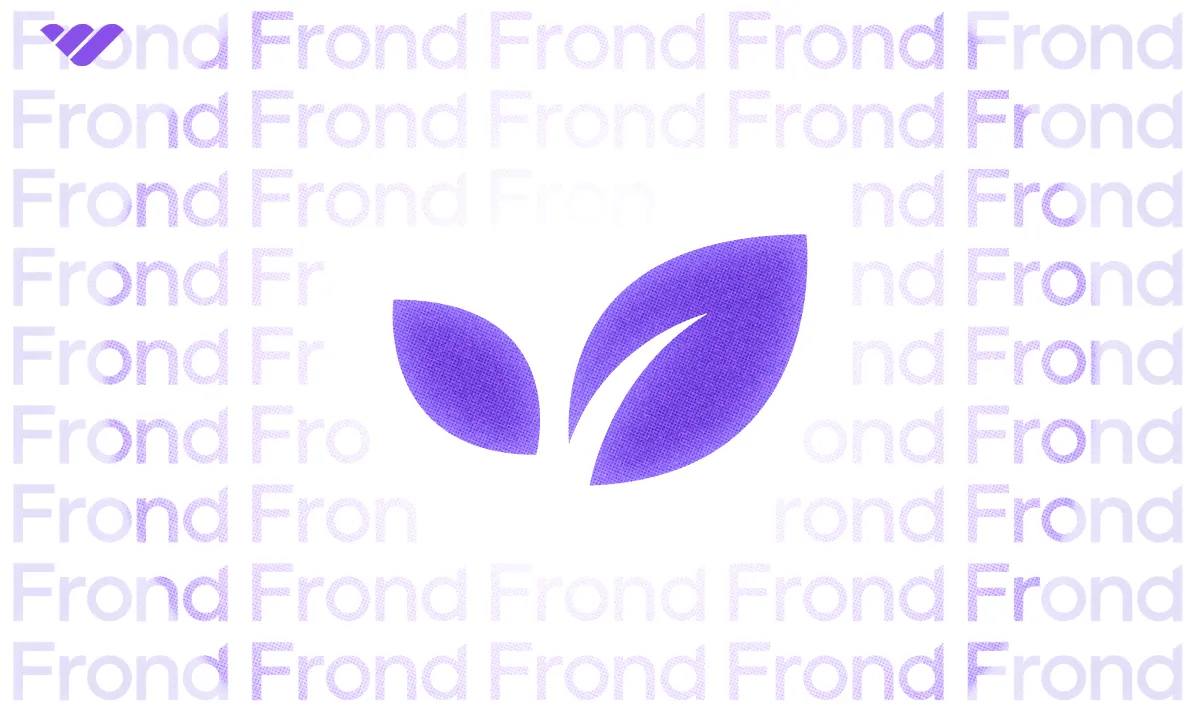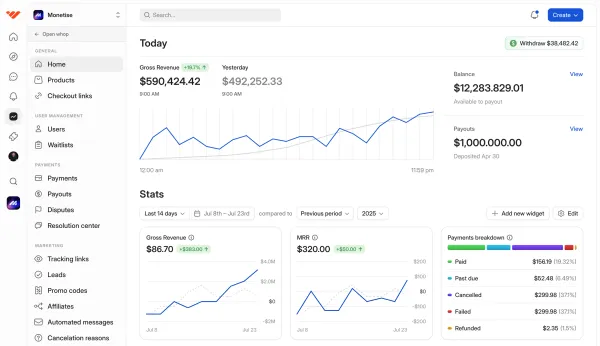Is Frond the best community platform for monetizing content? Discover pricing, pros and cons and how it compares to rivals in Whop's review.
Key takeaways
- Frond costs $49-99 monthly with 1-2% transaction fees versus 5% on free version.
- 66% of professionals report product feedback sharing as main community business benefit.
- Frond combines traditional forums with real-time messaging like Slack or Discord.
- Free Frond version limits file sizes and charges 5% transaction fees.
- Whop charges only 2.7% plus $0.30 per transaction with no monthly fees.
Running a successful online business is the dream – building your brand, showcasing your talents, and making good money. It’s possible in today’s world, but it takes more than a website and a few Facebook ads to stand out.
True success requires giving people a reason to choose you over the competition. A strong, engaged community is the backbone of every thriving online business. To grow your brand and boost revenue, you need to build an online community – a digital hub where your audience can connect and interact.
But finding the perfect platform for your business isn’t easy. With so many out there, which should you choose?
If you’re struggling to decide which to go for, you’re in the right place. In this guide, we’ll introduce you to Frond – one of the leading community platforms available today. We’ll cover what it offers, how much it costs, and explore its pros and cons.
And, if that’s not enough, we’ll also take a look at how it shapes up against the competition. Ready to get started?
What is an Online Community Platform?
An online community platform is a digital space where people can interact, connect, bond, and generally geek out about a topic or interest. The earliest versions of this would be forums or chatrooms where people could swap ideas about particular topics. They would usually be organized into sections.
Next came social media networks, ecommerce websites, and blogging sites, and luckily for entrepreneurs and creators, the evolution continues. Today we have access to hybrid platforms that give like-minded people somewhere to connect, but also include areas where you can publish content.
This content could be freely accessible, purely intended to educate or entertain your audience. The potential benefit of this is an engaged audience that is personally invested in you/your brand, and there’s huge potential in that.
The Power of Community
According to an early 2023 survey among global professionals, approximately 66% of respondents stated product feedback sharing is one of the main ways that community members contribute to their business. Other big benefits included submitting suggestions for products (62%) and evangelizing products (55%).
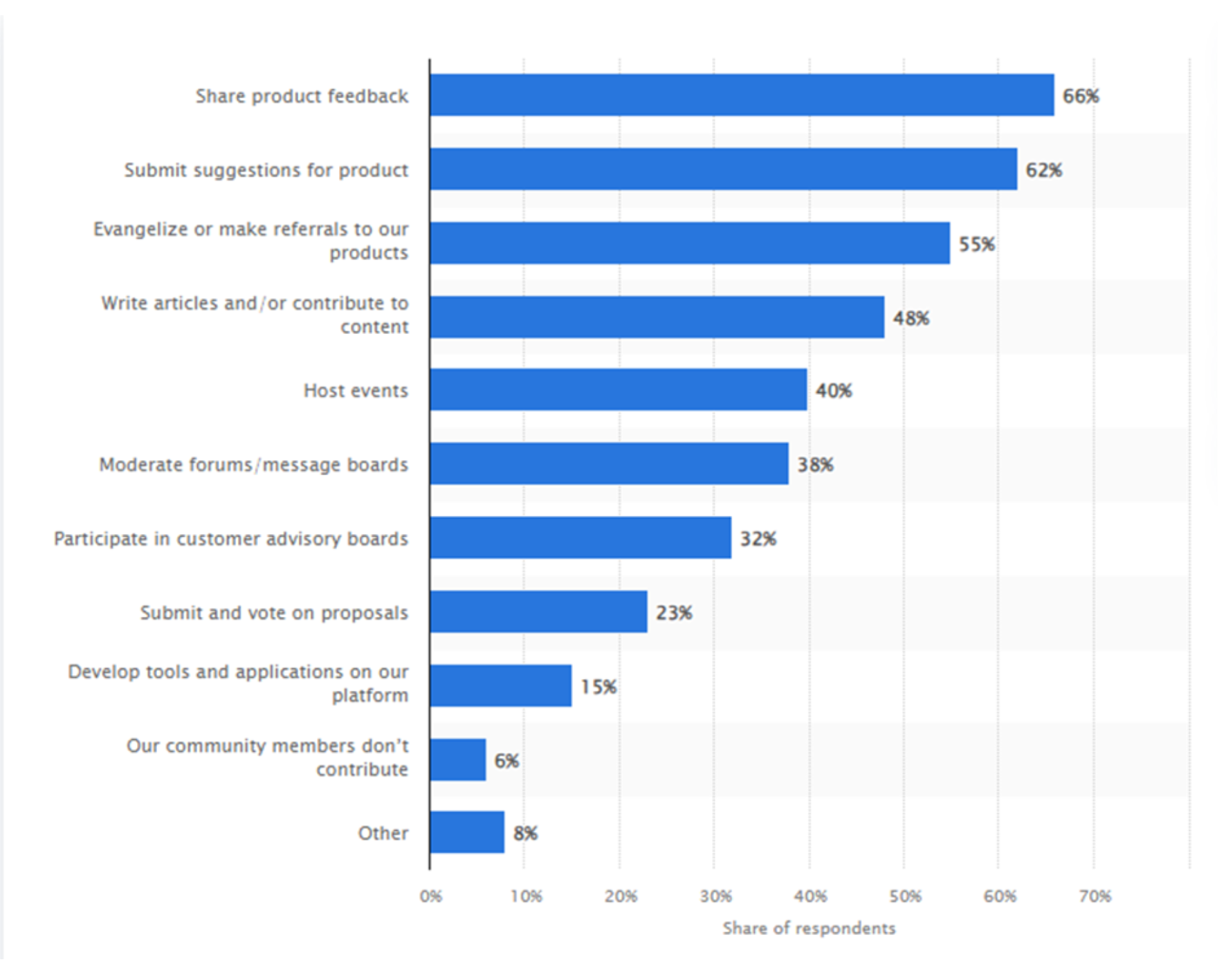
But that’s not all your community members can bring to the table.
If your goal is to make money, there are plenty of platforms that enable you to charge a fee before letting people access your content.
Types of Community Platforms
One community platform is not necessarily the same as the next, and choosing the best platform will come down to what you want it to do for you.
Broadly speaking, there are three main categories of community platforms.
Personal 👤
A personal community platform would provide people with a place to communicate with family and friends, for leisure and recreation. The platform could be as simple as a messaging tool like WhatsApp, or it could offer more complex features like live streaming.
Creative 🎨
Community platforms can be ideal tools for creators looking for ways to share their content with a wider audience and even monetize their content by integrating payment gateways - like TikTok.
Entrepreneurial 🚀
For more established brands and online businesses, there are community platforms that offer more bespoke functionality and branding such as apps.
When researching where to build your online community, you’ll find that there are lots of platforms out there, including Frond.
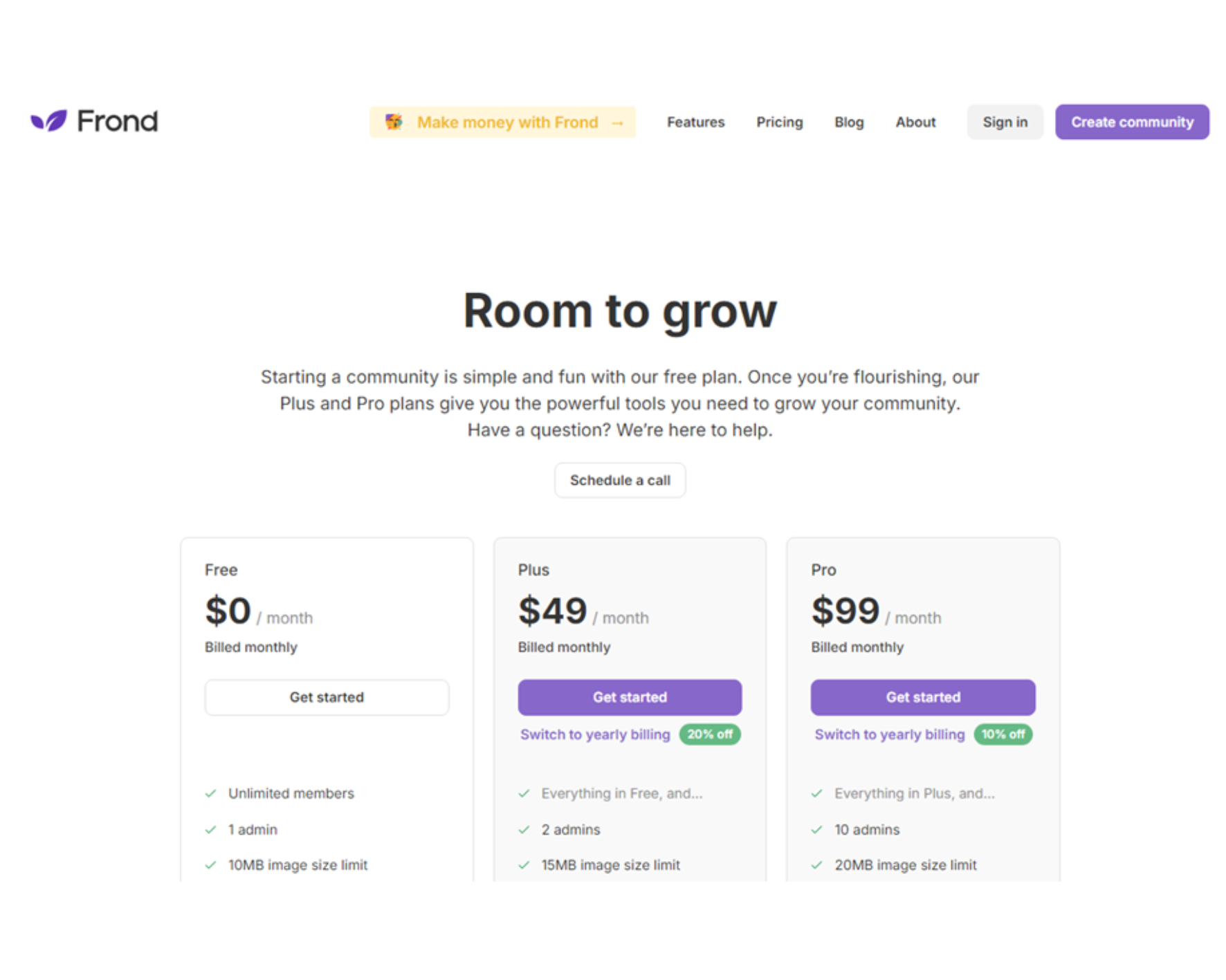
How Does Frond Work?
Frond is a tool that enables you to build an online community. It is the brainchild of Matt Blackshaw (who founded Sold) and the founder of Loom, Jan Senderek.
Frond could be described as a combination of the traditional forum or social media platform – where users can publish posts, videos, links, photos, or long-form writing – with a slicker real-time messaging platform like that of Slack or Discord.
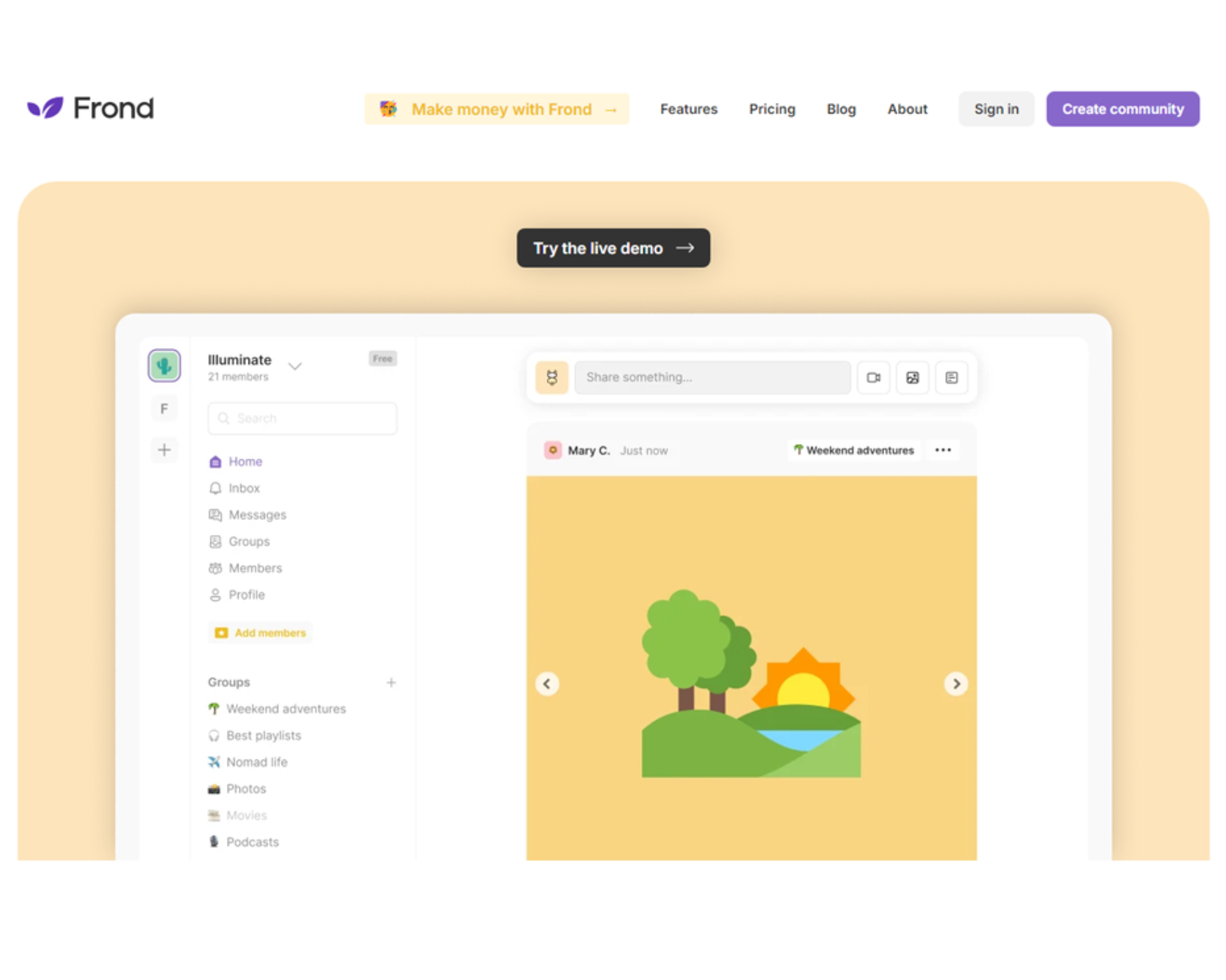
What Types of Communities Does Frond Support?
Frond offers a platform that could work for lots of different communities. There isn’t really a limit to the ways that Frond could be used, but examples might include a sports or fitness group looking to share exercise tips, employees looking for somewhere to collaborate or socialize, or a business could use it to offer support to customers.
Of course, it could also be used by an individual looking for somewhere to connect with friends and family, and creative entrepreneurs looking to monetize their content.
Essentially, any group that wants to create an online space for communication, bonding, and collaboration can use Frond.
How Do You Use Frond?
Frond community members can publish content on the platform, whether that’s a few sentences, an academic essay, a video, or a link.
Other members can then add comments to the content, which are automatically organized into threads or groups. This makes it easier for users to follow conversations, engage with each other, and dive deeper into a particular topic. The conversations can be public or private.
The organized threads are ideal for users who want to maintain structure, accessibility, and clarity in their discussions. It also helps to encourage participation from as many members as possible.
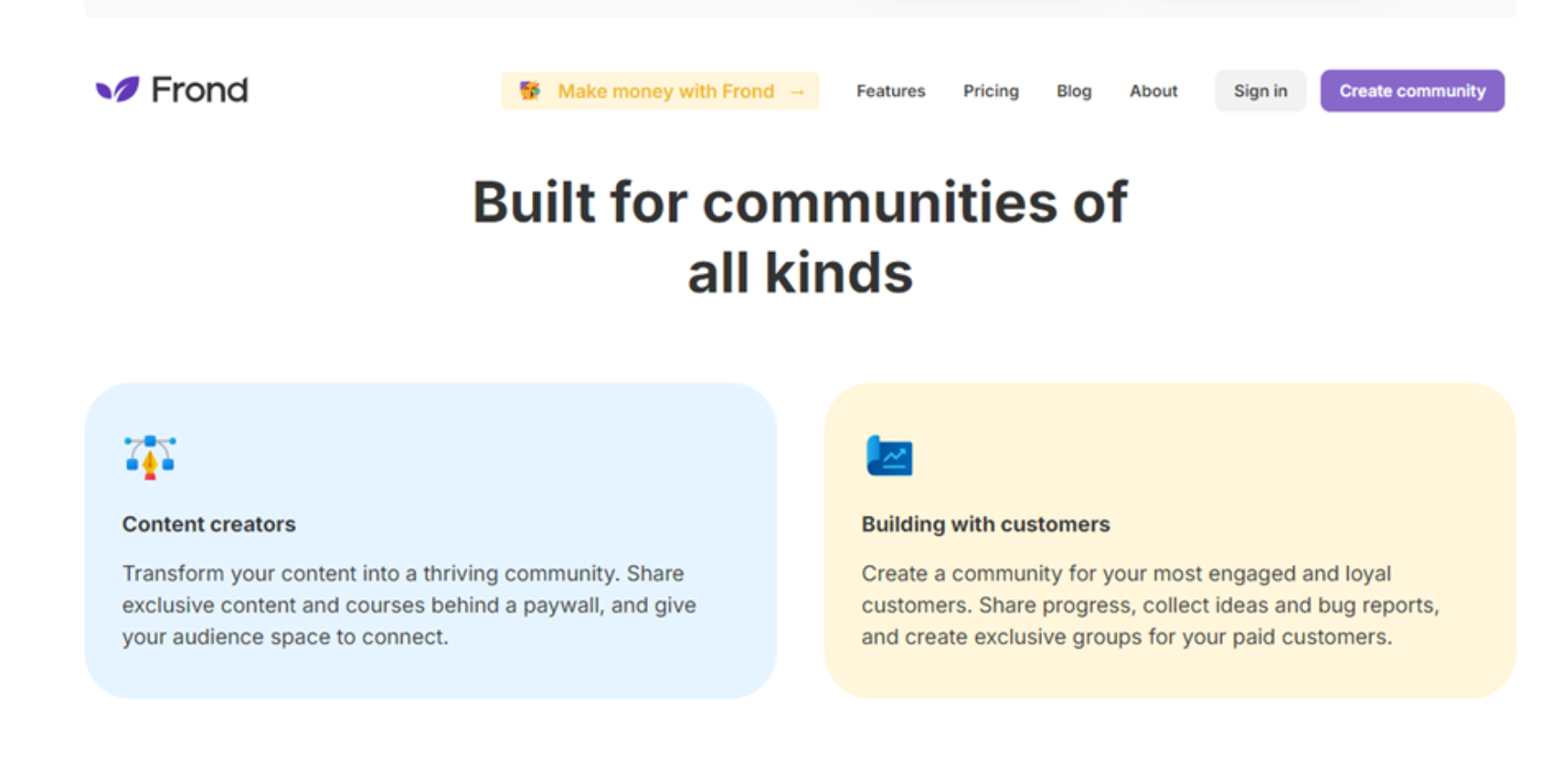
In terms of usability, Frond’s sleek interface design is all about simplicity and easy navigation. Plus, as Frond is an open-source platform, the community members are in control of their data and can influence the direction that the community takes.
From the community builder’s point of view, the ability to customize spaces means they can create a platform that is personal to them, appealing to their audience, or representative of their business.
Frond’s Usability and Key Features
Frond has a good Product Hunt review rating of 4.7/5, but as reviews are limited, it’s difficult to give a fair summary of user experience.
However, the platform comes with a solid range of features, including:
- Monetization options with paywalls
- Event creation
- Course design and monetization
- Engagement and activity insights
- Poll creation
- Ability to set user roles
- Groups and threads
- Rich posts
- Instant messaging
- Photo, video, and file sharing
- Widgets for websites
- Unique member profiles
- Public and private community options
How Much Does Frond Cost to Use?
All those lovely features are on offer, but now we get down to the business end of things.
Frond offers three different levels or ‘plans’, each of which offers various functionality. Let's take a look at them.
Free version of Frond
There is a free version that doesn’t require you to add any credit card information or sign up for a trial, but as you might expect it doesn’t include all the features. Images must be under 10MB, videos under 100MB, and you can't create polls, events, or courses.
It’s also important to note that Frond’s free version will charge you a 5% fee on every paywall transaction, which will eat into your earnings.
Paid version of Frond
For a monthly fee ($49 for Frond Plus or $99 for Frond Pro), you can unlock more functionality and reduce the transaction fee to 1-2%.
For $49 a month you reduce your transaction fee to 2% and have increased size limits for images and videos, in addition to the ability to create polls, custom member rolls, events, and use a custom domain. Plus, you can have 2 admins rather than 1.
For $99 a month you can have 10 admins, your image and video limits increase again, transaction fees reduce to 1%, and you also get to create courses and gain community insights - crucial for running a business.
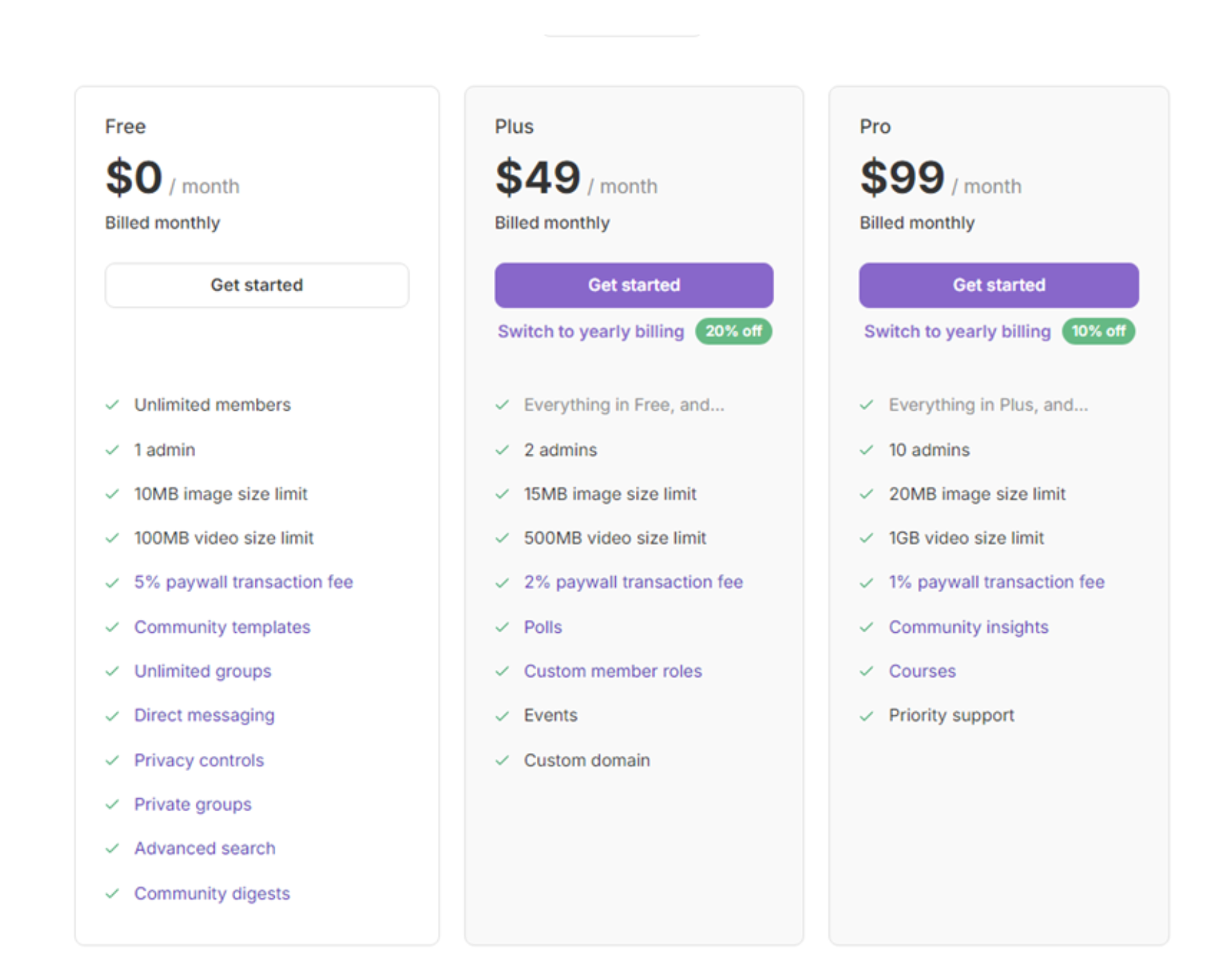
Is there a way to try Frond for free?
Frond gives you the option to use it without signing a contract or adding credit card information, so while it’s not an official trial, you can test it out before deciding if you want to upgrade to the Plus or Pro versions.
The free version offers:
- Unlimited members
- Community templates
- Unlimited groups
- Direct messaging
- Privacy controls
- Private groups
- Advanced search
- Community digests
However, the free version limits you to just one admin user, and there are limits in terms of the size of the video and image files that can be uploaded.
When you combine this with the 5% transaction fee, the free version of Frond may not be the most effective way to monetize your community.
What are the Alternatives to Frond?
Frond is not the only fish in the sea when it comes to building an online community and monetizing your digital content.
There are plenty of free and paid platforms out there helping entrepreneurs and businesses grow their audience and maximize their sales. Here are a few Frond alternatives to compare.
Whop 🏆
The strongest alternative to Frond is Whop. With Whop, you get endless options for monetizing a huge range of digital products, including courses, ebooks, communities, files, and more. In addition to the creative flexibility and the user-friendly interface, what’s even more appealing is that Whop is free to use – and there’s only a 2.7% + $0.30 fee applied to purchases - with no features locked behind a paywall.
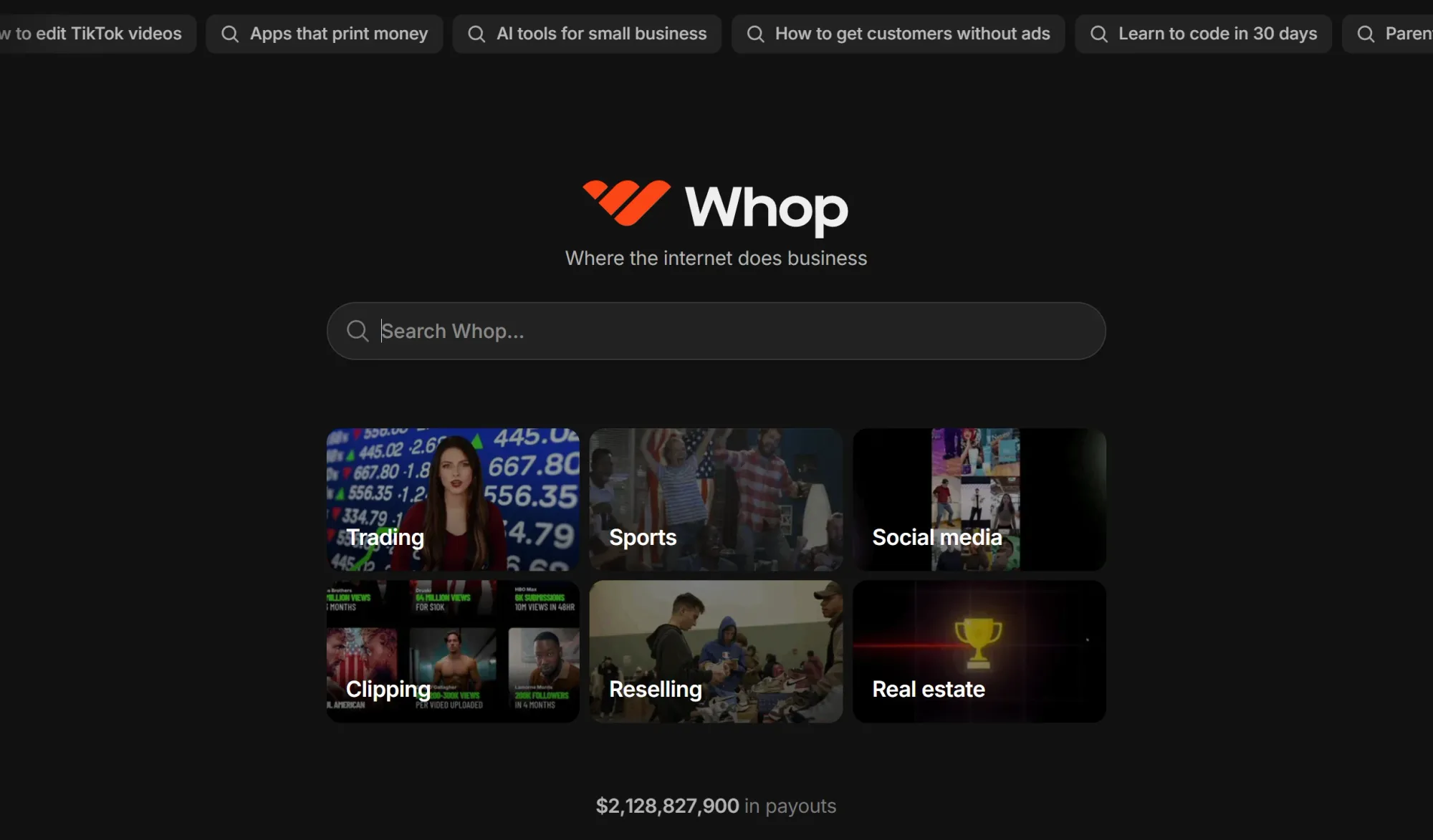
Memberful

Memberful provides you with a flexible membership website that can be integrated into an existing website or hosted separately. Like Whop, Memberful gives users lots of content options, from newsletters to podcasts to ebooks, and can be integrated with other marketing tools such as Mailchimp.
A potential drawback of Memberful, however, is the restricted payment options. Memberful can only accept Stripe payments, meaning customers can only buy from you if Stripe payment processing is available to them. Stripe also charges fees for processing transactions, which again reduces your margin.
Discord
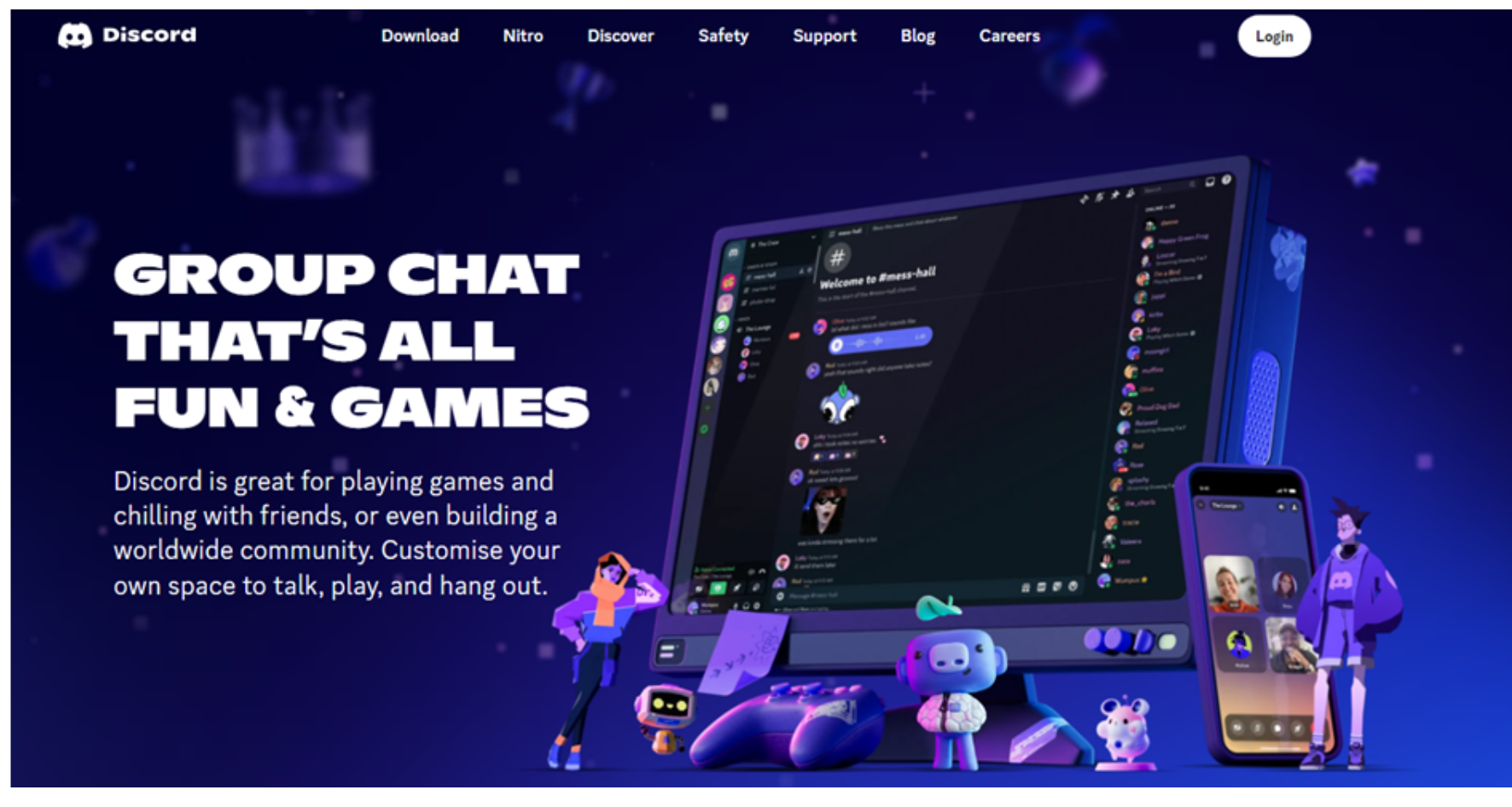
Discord started as a community platform for gamers, but over time it has attracted different communities looking for real-time communication via video, text, and voice.
Discord provides a dynamic and fast-paced atmosphere for users that can work well for some, but there’s no denying that the continuous stream of sometimes chaotic chatter is not the right fit for every group.
Choosing the Best Community Platform for You
The big question is…which community platform is the best? Of course, all the platforms have their advantages and drawbacks. If you are struggling to choose a community platform, it comes down to deciding what matters most to you and what you want to achieve.
Think hard about your audience, how they communicate, where they tend to interact now, and the types of content they will find most engaging.
The variety of content and communication options is also important in terms of maximizing your income. This might include digital downloads, subscription plans, one-off product sales, discounts, events, or courses. The more options you have, the more chances you will have to diversify your income streams in the future.
Finally, and possibly most importantly, make sure you have a clear understanding of the platform’s payment processing infrastructure and any fees you will be charged. Failed payments and high transaction fees are going to eat straight into your bottom line.
Create Your Online Community for Free With Whop
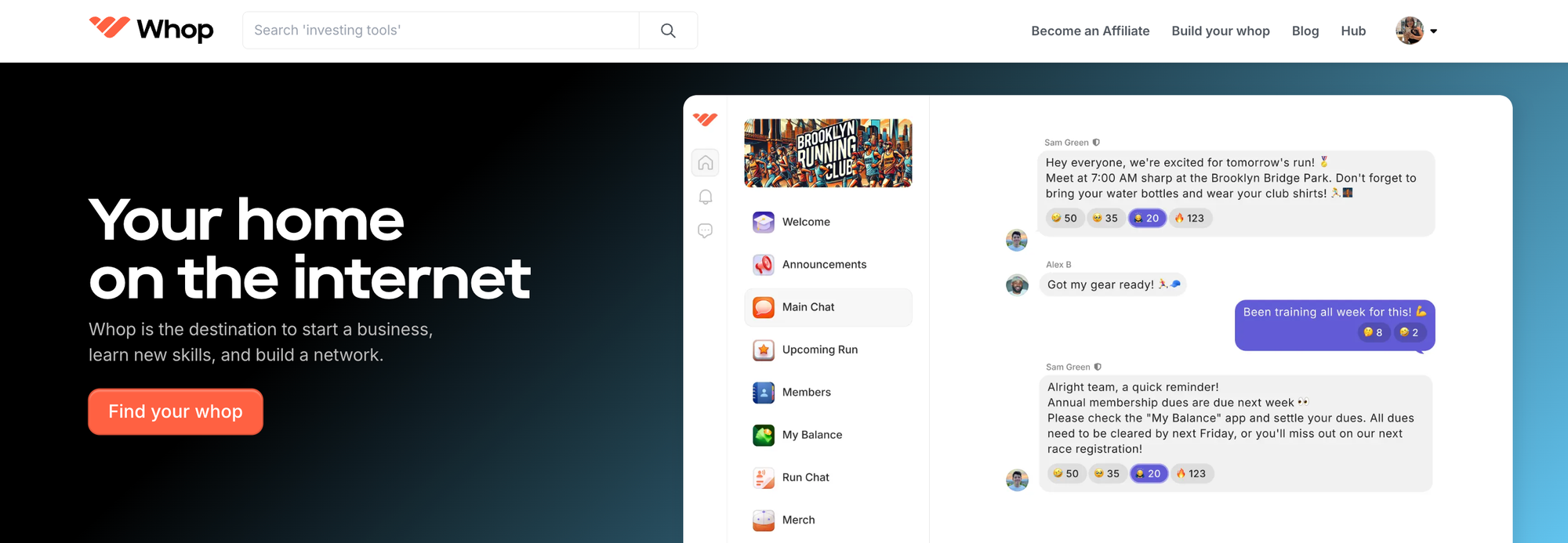
When on the hunt for the ideal online community platform, you need to find a balance between the features to give you room to create and engage with your audience, affordable costs, and the right level of support to help you grow your business.
When it comes to community management features such as endless monetization options, reliable payment processing, and exceptional customer support, the answer for more and more entrepreneurs is Whop.
Get started with Whop today and supercharge the growth of your new online community.


